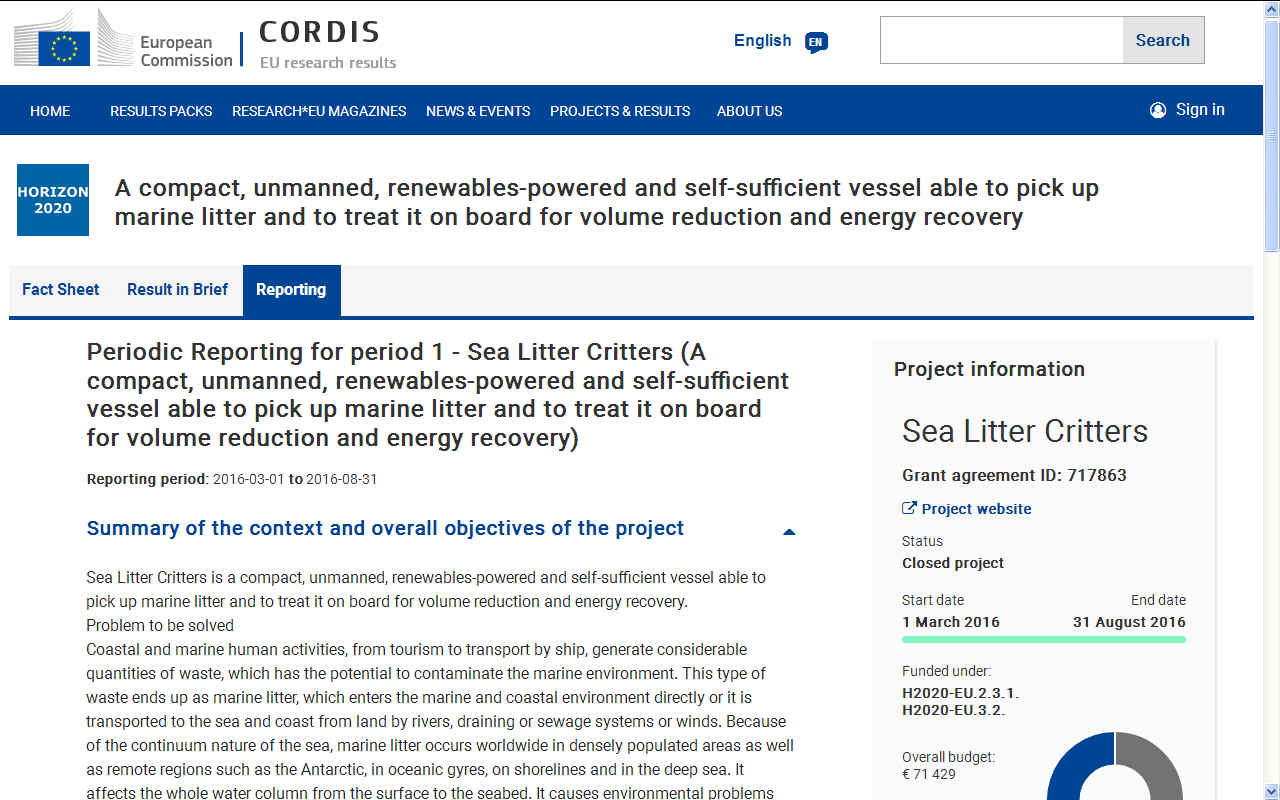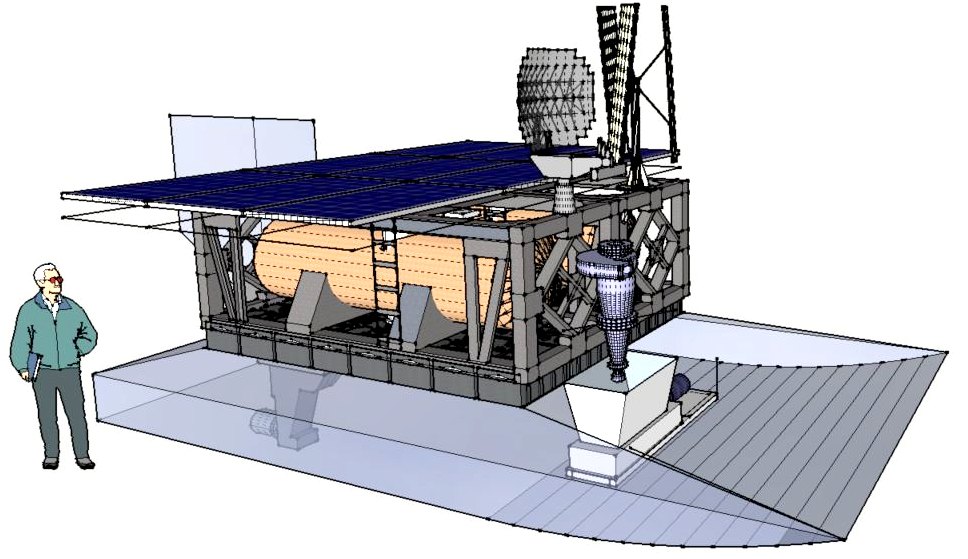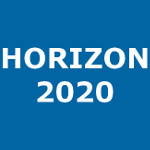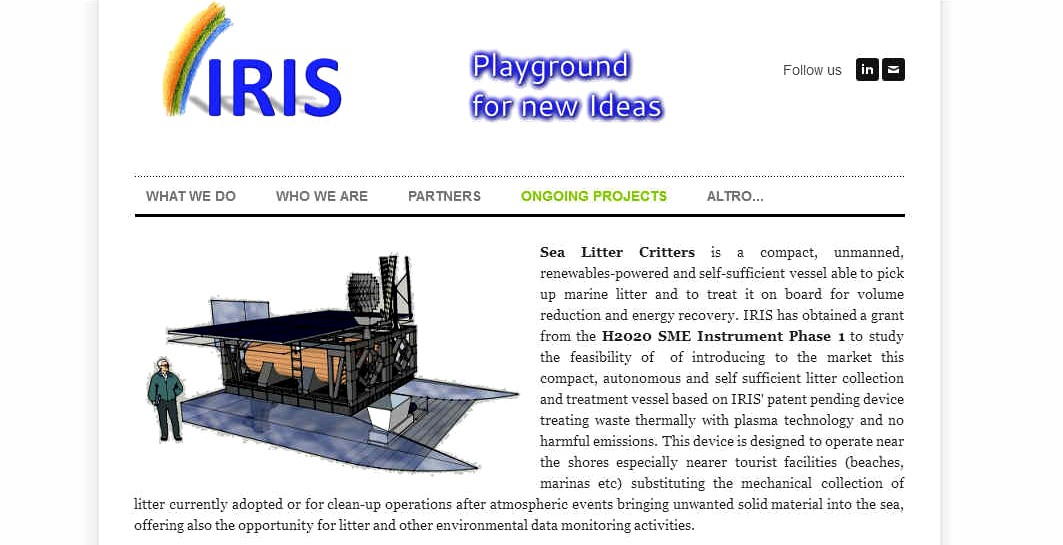|
CRITTERS FOR SEA LITTER
|
HORIZON 2020 - This project was funded by the European Union as part of their agenda to encourage investment from industry and get the brains of Europe thinking about different ways of cleaning up the mess we've made. The cost of accepting money from the EU is giving away your ideas by way of collaborative research. But in this case there is no means to charge for cleaning up services, where the international community at large are the culprits and nobody is accepting responsibility for marine pollution, despite the fact it is illegal to dump plastic in the sea.
A compact, unmanned, renewables-powered and self-sufficient vessel able to pick up marine litter and to treat it on board for volume reduction and energy recovery
FACT SHEET
This study aims to check the attractiveness of the innovation to the market involving potential customers (coast towns, associations of tourist and fishing ports and marinas, representatives from the cruise and hotels industry, marine natural reserves authorities). The first markets identified are on the Mediterranean Sea, which is at the center of a very highly populated area of the World with many Countries relying mostly on tourism. Studies confirm that the Med has mostly marine litter derived from this economic activity and up to 80% of it originating from land. Italy, with its over 7600km long coastline and a strong dependency upon tourism, will be the first market, followed suit by France and Croatia and then Spain and Greece. After a 3 year phase to cover development, industrialisation and commercialisation, production is expected to start in 2019, with employment of 17 new staff.
RESULTS IN BRIEF
Cleaning up with the Sea Litter Critter
This gave IRIS, a small start up based in Turin, Italy, the idea to use their expertise in plasma technology to come up with an improved solution. Using plasma - a very high temperature, very energetic state of matter - solid waste can be completely broken down with no risk of dioxines and furans emissions, which can form in other combustion-based waste treatment methods. At SEA LITTER CRITTERS’s core is IRIS’s small scale pyrolizer unit (patent pending), which treats thermally solid waste and transforms it into syngas, a mixture of hydrogen, carbon monoxide, and methane and a residue which can be recycled as aggregate for road material or concrete. The syngas could be exploited for producing electricity or fuelling the vessel’s motor. Currently a fully unmanned, automated device is not possible due to regulatory and technology limitations but Schiavi says, ‘Ideally, once automated navigation is fully developed, this vessel could be left to hoover up marine litter day and night.’
In their feasibility study the team commissioned specific market research to ascertain if the device was attractive to coastal resorts, municipalities and aquaculture enterprises. While the idea was found to be of interest to the market, the main challenge was found to be securing the necessary investment for such equipment. Schiavi notes, ‘Currently, marine litter is everybody’s problem but nobody wants to pay for cleaning it up, and there are no regulations stipulating who should be dealing with it.’ Changes to the current regulatory climate, could kick-start a market for this device, as Schiavi explains. ‘The EU is very active on the subject as the problem is growing to a level likely to affect European industries such as fishing. So we expect that the regulatory landscape will change, and there will be a requirement for local authorities to act.’ The project team is working towards developing a sea-ready vehicle to be tested within the next four years. It expects disposal of marine litter through thermal treatment will have a place in the future management framework for materials that cannot be recycled or for emergency situations such as spills and flooding events.
DIAGRAM - This drawing gives you an idea of scale, should a prototype ever be built. It looks to be slightly smaller than the coastal version of SeaVax. IRIS are partners on the CLAIM plastic project that was ongoing in 2019.
REPORTING
Periodic Reporting for period 1 - Sea Litter Critters (A compact, unmanned, renewables-powered and self-sufficient vessel able to pick up marine litter and to treat it on board for volume reduction and energy recovery)
It affects the whole water column from the surface to the seabed. It causes environmental problems (death of marine animals by entanglement and ingestion; smothering of marine vegetation and corals; contamination of sea environment by toxic components released through break up; transport of alien species etc.), economic problems (reducing the recreational value of water and coast therefore attractiveness for tourists, affecting fishing and fish farming, damaging boats) and social problems (pollutants and toxins entering the food chain through ingestion by sea creatures, from plankton to larger
fish, with consequent effects on human health). Globally, it is not known with confidence how much litter is currently within the sea system nor how much is entering the sea annually, although a report published in January by the
Ellen MacArthur Foundation states that in a business-as-usual scenario, the ocean is expected to contain one tonne of plastic for every three tonnes of fish by 2025, and by 2050, more plastics than fish [by weight].
All studies highlight that plastic is the most common type of material found amongst the litter items, be it household items to fishing gear lost at sea. This poses a major problem as plastic is a persistent and pervasive pollutant: in such a harsh environment, plastic items become brittle and break down into small particles, but basically never dissolve. The particles can be eaten by zooplankton thus bringing toxins into the foodchain. Therefore, actions to prevent plastic entering the sea (minimisation of waste, use of biodegradable plastic, awareness raising) as well as actions to minimise the effects it has on the environment are required.
Picking up litter while it is still intact, like through beach clean up days or the KIMO’s Fishing for Litter initiatives, helps in reducing the risk of plastic breaking down into finely dispersed particles, as well as mitigating the effects, e.g. on the recreational value of the coast, and raising awareness. Alongside these high profile environmental initiatives, there is evidence of stakeholders, particularly from the tourist sector, taking matters on their hand: Local Authorities organise themselves, often in cooperation with local retailers and hotels.
WORK PERFORMED BEGINNING TO END + RESULTS
It also required a study of key drivers, restraints, and opportunities expected to influence the market growth during the said period. Finally, it was requested to provide industry development and product concept testing analysis of the automated marine debris collection equipment market based on automation level and provision for waste treatment. IRIS also interviewed representatives of the committee Consorzio Promotour, grouping retailers, hoteliers and beach management companies in the Blue Flag municipality of Celle Ligure, on the Italian Riviera. The Consorzio manages a service for the cleaning of the sea in front of the beaches, undertaken by a small boat that travels along the coast using a net to trap floating debris.
Other stakeholders contacted directly included NGOs working on marine environment protection and Authorities/business representatives of coastal areas, as well as Universities/research centres and innovative SMEs with interesting technologies. IRIS also took part to the
European Maritime Day in Turku, Finland, learning about the sector, meeting potential suppliers/industrial partners and attending workshops on marine litter.
PROGRESS BEYOND THE STATE OF THE ART & EXPECTED SOCIAL IMPACT
It is recognised that Sea Litter Critters is not the solution to marine litter but it provides a practical choice for clean ups and upkeeping of cleaner shores in the short-medium term, and a quick, viable solution for emergency situations.
IRIS has concluded Phase 1 with an elaborated business plan that will be used as a basis for a Phase 2 application to be submitted 2017. Work on the development of the technology is continuing through self funding and local initiatives involving also local
Universities.
OCEAN CLEANUP PROJECTS A - Z
* Adidas * Algalita research foundation * Aliance to end Plastic Waste AEPW * Baltimore Mr Trash river cleaning barge * BAN - Basel Convention Action Network * Boyan Slat's ocean booms * CLAIM H2020 EU marine plastic project * Earth Day - Fact sheet ocean plastic * Fionn Ferreira's ferrofluid extraction of microplastics * FlashLight Press Michelle Lord & Julia Blatt * GRIPS - Global Research & Innovation in Plastics Sustainability * Interceptor tethered river cleaning barges * Junk Raft - plastic awareness voyage * Kids Against Plastic Tat KAPTAT * Miss Ocean - Plastic Awareness Events * 4Ocean recycled plastic bracelets * Nike - Sneakers from recycled materials, ocean spills * Plastic Oceans Org * Seabin * SeaVax autonomous drones * Surrey University PIRATE & Triton * Sussex Bay - Coastline marine rewilding project * WRAP - Waste & Resources Action Programme
Sea Litter Critter is not alone in the fight against ocean plastic. These emerging technologies could all play a part in containing the mountain of plastic that is accumulating on the oceans floors, by recovering floating debris before it sinks. New ideas are welcomed.
LINKS & REFERENCE
https://cordis.europa.eu/programme/rcn/664281/en http://www.irissrl.org/ https://cordis.europa.eu/project/rcn/200326/factsheet/en
IRIS
-
A concept to take advantage of laser treatment
of waste. Corso Unione Sovietica 612/21 - TORINO - Italy
|
|
ABS - BIOMAGNIFICATION - CANCER - CARRIER BAGS - COTTON BUDS - DDT - FISHING NETS HEAVY METALS - MARINE LITTER - MICROBEADS - MICRO PLASTICS - NYLON - OCEAN GYRES - OCEAN WASTE PACKAGING - PCBS - PET - PLASTIC - PLASTICS - POLYCARBONATE - POLYSTYRENE - POLYPROPYLENE - POLYTHENE - POPS PVC - SHOES - SINGLE USE - SOUP - STRAWS - WATER
|
|
This website is provided on a free basis as a public information service. copyright © Cleaner Oceans Foundation Ltd (COFL) (Company No: 4674774) 2023. Solar Studios, BN271RF, United Kingdom. COFL is a company without share capital.
|



